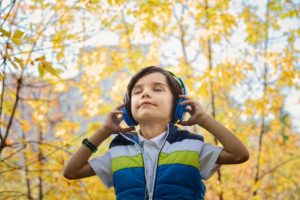There is still a debate whether talents other than math and language are indeed types of intelligence or just skills.
What do you think?
Recognizing multiple intelligence can be particularly useful if you are a special education teaching assistant on a teach abroad program.
For more information on courses and internships for special education assistants abroad have a look here:
https://evolveabroad.com/special-education/
Using Multiple Intelligence on teach abroad programs
Howard Earl Gardner an American psychologist and the founder of applied psychology identified 9 different types of intelligence.
What other scientists thought were just soft-skills, such as interpersonal skills, Gardener realized were types of intelligence. Just as being a math genius gives you the ability to understand the world, so does being “people smart” give you that very same ability, just from a different perspective.
Imagine a learning environment which focused on learning techniques which recognized each of these 9 different types of intelligence. This would drastically enhance impact on a teach abroad program. These are the 9 different types of intelligence that Gardner identified:
- Naturalist (nature smart)
- Musical (sound smart)
- Logical-mathematical (number/reasoning smart)
- Existential (life smart)
- Interpersonal (people smart)
- Bodily-kinesthetic (body smart)
- Linguistic (word smart)
- Intra-personal (self smart)
- Spatial (picture smart)

Multiple Intelligence – Naturalist nature smart
Being a naturalist or nature smart means an individual is sensative to nature and the world. Naturalist intelligence deals with sensing patterns and making connections between elements in nature. Children possessing enhanced levels of “nature smarts” may be very interested in human behaviors, or the behaviors, habits, or habitats of other species. They may have a strong affinity to the outside world or to specific animals, and these interests often begin at an early age. Children possessing naturalistic intelligence may enjoy subjects, shows, and stories that deal with animals or natural phenomena, or they may show extensive interest in subjects like biology, zoology, botany, geology, meteorology, paleontology, or astronomy.
Children displaying “nature smarts” are often keenly aware of their surroundings and changes in their environments, even if these shifts are subtle. This awareness is due to their highly-developed levels of sensory perception. Their heightened senses may help them notice similarities, differences, and changes in their surroundings more rapidly than others do. Individuals with “nature smarts” may be able to categorize or catalog things quite easily. They often like to collect, classify, or read about things from nature for example rocks, fossils, butterflies, feathers, shells.
The combination and interplay of specific cognitive or mental constructs that may differentiate “nature smarts” from other intelligences include:
- Attribute Orientation – the ability to find common traits or commonalities among things, items, or arrays
- Categorization – the ability to identify categories by attribute or characteristic
- Hierarchical Reasoning – the ability to rank or order items by significance or relationship
- Schematic Memory – the ability to internalize and recall information by attribute category or hierarchical classification
- Natural orientation – the ability to identify with living organisms and their environments (this ability can offer changed or unique perspectives or encourage empathetic understanding)
People who excel in this intelligence typically are interested in growing plants, taking care of animals or studying animals or plants. Zookeepers, biologists, gardeners, and veterinarians are among those that Gardner sees as having high naturalist intelligence.
For more detailed information on teaching strategies for natural intelligence have a look at:
Teaching Strategies for Naturalist Intelligence
by Thomas Armstrong
Bringing the natural world into classroom learning.
Most of classroom instruction takes place inside of a school building. For children who learn best through nature, this arrangement cuts them off from their most valued source of learning. There are two primary solutions to this dilemma. First, more learning needs to take place for these kids outside in natural settings. Second, more of the natural world needs to be brought into the classroom and other areas of the school building, so that naturalistically inclined students might have greater access to developing their naturalist intelligence while inside of the school building. The strategies that have been selected for inclusion here are all drawn from one or both of these approaches.

Multiple Intelligence – Musical (sound smart)
Musical intelligence is the capacity to discern pitch, rhythm, timbre, and tone. This intelligence enables a person to recognize, create, reproduce, and reflect on music, as demonstrated by composers, conductors, musicians, vocalist, and sensitive listeners. Interestingly, there is often an affective connection between music and the emotions; and mathematical and musical intelligences may share common thinking processes. Young adults with this kind of intelligence are usually singing or drumming to themselves from a very early age and they are usually quite aware of sounds others may miss.
How to recognize if a child is music smart:
- Is it easier for a child to remember things when they are sung to a tune?
- Is it easier to concentrate when there’s music on in the background?
- Do they have a sharp ear for the multitude of sounds in any given environment?
- Are rhythms and melodies something they pick up easily?
- Is there any interest in learning to play an instrument?
As you might imagine, music-smart learners are particularly attuned to patterns, rhythms, melodies and song. This has broad implications, and goes far beyond playing a musical instrument.
Having a strong musical intelligence does not necessarily mean becoming a musician. This intelligence also extends to having a keen ear for the patterns and sounds of an environment for example, people who enjoy identifying birds and other animals based on their sounds. Poets and writers love the rhythm and song of well-crafted sentences, and experience how the musical elements of great writing influence the nuanced meanings of poems and stories.
Music-smart learners often retain new information more easily by turning facts into songs. Many people find it more natural to study or concentrate when there is music on in the background.
People who are music smart live and breathe music. This may happen in many different ways. Some people enjoy many different types of music, can understand musical notation, can critique types of music and talk about music in an in-depth manner. Some like to create new instruments or learn to play a variety of instruments. Some create their own lyrics and sing solos or sing in choirs. Like all of the intelligences, there are many different ways to be music smart and someone who may not be a good singer might be a great composer. Someone who loves music, may like to dance to express the feelings that music cause but might not be able to play an instrument.
Children who are music smart could grow up to be musicians, music critics, composers, singers, sound engineers, producers, instrument makers, conductors, band or choir teachers, storytellers, poets, song or jingle writers, radio.

Multiple Intelligence -Logical-mathematical (number/reasoning smart)
This multiple intelligence is strongly correlated with the traditional definition of IQ. Logical-mathematical multiple intelligence learners quantify or conceptualize information in order to process it. These individuals naturally excel in mathematics, chess, computer programming, reasoning capabilities, abstract patterns of recognition, scientific thinking and investigation, and the ability to perform complex calculations. While you are working on a teach abraod program when presented with a challenge in a weaker area of intelligence, encourage children to think about activities or ways that can link these weak areas to their strongest intelligences.
Logical-mathematical intelligence is the ability to calculate, quantify, consider propositions and hypotheses, and carry out complete mathematical operations. It enables people to perceive relationships and connections and to use abstract, symbolic thought; sequential reasoning skills; and inductive and deductive thinking patterns. Logical intelligence is usually well developed in mathematicians, scientists, and detectives. Young adults with lots of logical intelligence are interested in patterns, categories, and relationships. They are drawn to arithmetic problems, strategy games and experiments.
Multiple Intelligence -Existential (life smart)
Existential intelligence is the label Howard Gardner gave to students who think philosophically. Existential intelligence involves an individual’s ability to use collective values and intuition to understand others and the world around them. People who excel in this intelligence typically are able to see the big picture. Philosophers, theologians and life coaches are among those that Gardner sees as having high existential intelligence.

Multiple Intelligence -Interpersonal (people smart)
Children who have this intelligence are good with people and understand what others want and need. These children can often read and understand body language and be persuasive and bring people to consensus. If you have several close friends and like to work on group projects or participate in group sports. Then you are more than likely people smart. Individuals who are people smart will be highly valued on teach abroad programs and would naturally demonstrate intercultural intelligence.
People smart people generally get along with others because they are in tune with others and their thoughts and feelings. They like to be around people in social settings, club, or sports activities. They aren’t afraid to share their opinions and work with people to get everyone on the same page. Because they can work with people and understand their motives and desires and how to communicate with them, people smart individuals often make great leaders. They also may find themselves helping others with their problems a great characterisic for anyone wishing to teach abroad as a special education assistant.

Multiple Intelligence -Bodily-kinesthetic (body smart)
Do you remember that student in class who was always drumming their hands on the desk, fidgeting in the chair, and grabbing any excuse that came along to get up and DO something? This is called Bodily-Kinesthetic Intelligence, or, more simply, Body Smart.
Some of us are wired to move, whether with our whole bodies in dance or athletics or with our hands in jewelry-design, engine repair, or brain surgery! When we, as educators, welcome and appreciate this, it allows these brilliant children to grow and develop their amazing gifts.
With that in mind, let’s take a peek into this Body Smart Intelligence
People who have ability in this area are very aware of—and are very much in control of—their movements. They are able to use their bodies in ways that make the rest of us scratch our heads. Athletes (everyone from synchronized swimmers to marathon runners), woodworkers, dancers, mechanics, sculptors, jewelers, body builders, cake decorators, calligraphers, joggers, bicyclists, and more are intelligent in this way. . .Both large and small motor skills fit within this area.
Some of the characteristics of this intelligence are:
- Need to move in order to listen
- Is a kinesthetic or tactile learner
- Always physically in motion, even while standing still
- Develops abilities in handcrafts and other small motor skill activities
- Experiences a physical sensation which directs in problem solving
- Learns from fiddling with stuff, i.e. disassemble, reassemble
- Enjoys athletic competition
- Loves activities that engage the large muscle groups, like running, etc.
If children are strong in this intelligence, you need to make time in your schedule for movement and activity! Really. Get everyone up off the chairs and play a game of tag. Run around, literally. Go for a bike ride. Fly a kite. Whatever kind of physical activity is enjoyable and appropriate.
Multiple Intelligence -Linguistic (word smart)
- If a person likes words and language and are a good listener,
- If a person likes to read, to spell, to tell stories, and to tell jokes,
- If a person likes to journal, to listen to audiobooks, and to talk about books
They are word smart.
People who are word smart love language. They may be a strong speller. They may love to read. They may love to write. Someone who is word smart might not necessarily be able to read really fast or spell really well but he/she can spin a really good story. There are many different ways to be word smart and someone who is word smart won’t necessarily be good in every aspect of this intelligence.
Children who are word smart might grow up to be writers, journalists, comedians, politicians, speechwriters, teachers, librarians, proofreaders, publicist/public relations specialists, radio or television announcers, and storytellers.
Multiple Intelligence -Intra-personal (self smart)
Does a child enjoy doing things on their own? Do they spend a fair amount of time thinking and reflecting on there own feelings and actions, or those of other people? Are they drawn to creative forms of self-expression? The word ‘intrapersonal’ means “within oneself, on the inside”.
Self-smart learners have a strong awareness of their own thoughts, feelings, ideas, motivations and goals. They are reflective individuals interested in personal expression. Although intrapersonal learners are very empathetic, they don’t always express it and are often more comfortable working on their own.
Self-smart people are skilled at identifying their own strengths and weaknesses. They enjoy planning and setting goals, and often need time to be alone to process their experiences and/or for creative expression.
For teaching tips for children who are self smart have a look at this video:
https://www.youtube.com/watch?time_continue=9&v=bpvKr8GOC84

Multiple Intelligence -Spatial (picture smart)
Picture Smart people notice color and patterns and may doodle a lot. They may express themselves in artistic mediums instead of solely in words. They may think better when they are drawing out their thoughts and feelings.
They may be artists, sculptors, painters, illustrators, computer animators, art teachers, graphic artists, photographers, movie producers, or any kind of designer (interior, landscape, fashion etc.).
Of course accurately matching and facilitating an appropriate learning style with a child’s particular intelligence will greatly enhance their learning experience and knowledge retention!
According to an article in education degree there are 7 different learning styles if you can accurately match these learning styles with a individuals unique intelligence you will significantly improve knowledge retention and the learning experience for the individual.
Find more detailed information on the 7 different learning styles here:
https://www.educationdegree.com/articles/different-types-of-learning-styles
Seven Different Types of Learning Styles you can use on teach abroad programs
1.) Visual Learners.
Students who are natural visual learners will be better taught with as many pictures and imagery for explanation of concepts. If you are teaching them geography, be sure to include plenty of maps. The same approach is true for history teachers. There are so many artistic depictions of all eras in human history, you shouldn’t have a problem adding some visual elements to any kind of lecture or presentation.
2.) Aural Learners.
Learners who respond primarily to sound can be challenging for teachers who aren’t teaching a lesson about music. But there are techniques you can use to stimulate students who respond to sound, if you do your homework.
These students are ones who know how to sing, play in the school band, or have their own musical hobbies. Music is also known to illicit strong emotional feelings and responses from these types of students. Music they associate with events and times of their lives can sweep them back into their minds, where they will almost re-live the times and places they relate to the sounds they are hearing.
3.) Verbal Learners.
Verbal instruction, as well as writing activities inspire these students to absorb information most effectively. Students with strong verbal learning skills often become journalists, other types of writers, public speakers, and teachers themselves.
That’s why activities where these students get a chance to speak or present can be effective in bringing out their natural ability to verbalize information and give them confidence. Experts recommend many types of techniques for these students, that even include others who may not be as verbally inclined.
4.) Physical Learners.
Have you ever noticed people, or your students, who use their hands more than usual when they speak? They seem like they’re always in motion, and always have some form of physical movement like a conductor with their words.
These individuals are physical learners, and they express themselves in the same way. These types of learners respond to words that incite feeling and physical activity. They want to understand what it feels like to go through the motions of what they are learning.
There are many ways you can create physical exercises to help these types of students learn. Not only can you create activities where they are physically moving. But, you can use objects, like puzzles or other small objects to get them engaged with their learning.
5.) Logical Learners.
These learners are the ones who are always making lists, getting organized, and trying to find the link between one piece of the puzzle and another. Logical learners are a natural fit for mathematics, science, and other logic based subjects in school.
When you are teaching these learners, they can be great leaders or naturally take on a project manager type role in lab assignments, thanks to their want to put things in a neat, orderly way. These students can also be challenged to think from different points of view. They are naturals at seeking facts, and can often be found winning matches in chess club or outperforming their opponents in debate or math tournaments.
6.) Social Learners.
Social learners are natural group workers, and are the kinds of students who seem to be everywhere in school – at all the extracurricular activities, sports, band, debate, and socializing with teachers and students throughout the day.
7.) Solitary Learners.
Some people think that solitary learners are shy or sometimes rude because they often keep to themselves. They may come across as introverted, compared to the other different types of learners in the classroom.
These learners are also very concerned with goals and outcomes in curriculum. So be ready to explain exactly what they can expect to achieve in your class.
In summary if are able to identify a child’s particular intelligence and can then match this with the relevant learning style you can greatly improve their learning experience. This is a particularly useful skill for people interested in supporting special education.
You can find information on 12 ways to teach using multiple intelligence by Kim Haynes here:
http://www.teachhub.com/12-ways-teach-using-multiple-intelligences
And if you would like to find out which intelligence best suits you take this survey J
https://www.edutopia.org/multiple-intelligences-assessment
Finally if you are considering a career in education or teaching there are some excellent resources on https://www.teachingdegrees.com/ and https://www.speechpathologydegrees.com/.


